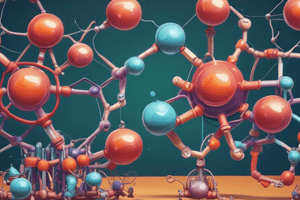Podcast
Questions and Answers
Which of the following is NOT a powerful electrophile?
Which of the following is NOT a powerful electrophile?
- PH3
- Br+
- AlCl3
- BF3 (correct)
What is likely the product formed from the reaction involving a cyclohexane ring with an -OH group?
What is likely the product formed from the reaction involving a cyclohexane ring with an -OH group?
- A cyclohexane ring with an -OH group and a +CO2 molecule (correct)
- A cyclohexane ring with an -OH group and a =O group positioned on opposite sides
- A cyclohexane ring with an -OH group and a =O group adjacent to it
- A cyclohexane ring with an -OH group attached to a =O group
Which of the following compounds is generally not used as an electrophile?
Which of the following compounds is generally not used as an electrophile?
- AlCl3
- Br+
- PH3 (correct)
- BF3
What type of reaction mechanism is indicated by the presence of CO2 production?
What type of reaction mechanism is indicated by the presence of CO2 production?
Which structural feature is common in the products of reactions with powerful electrophiles?
Which structural feature is common in the products of reactions with powerful electrophiles?
Which of the following statements accurately describes enantiomers?
Which of the following statements accurately describes enantiomers?
Which compound is expected to exist in optically active forms?
Which compound is expected to exist in optically active forms?
What is the name for the compound with the configuration (2R,3R)-2-bromo-3-chlorobutane?
What is the name for the compound with the configuration (2R,3R)-2-bromo-3-chlorobutane?
Which of the following is TRUE regarding an optically active compound?
Which of the following is TRUE regarding an optically active compound?
Which of these pairs may be separated by ordinary physical methods?
Which of these pairs may be separated by ordinary physical methods?
Study Notes
Organic Chemistry Concepts
- Plane-polarized light rotation indicates chirality in a compound.
- Chiral molecules lack an internal mirror plane of symmetry and exist as enantiomers, which are non-superimposable mirror images.
- Enantiomers exhibit different optical activities; one may be dextrorotatory (rotates light clockwise), and the other, levorotatory (rotates light counterclockwise).
Chiral and Achiral Compounds
- Compounds with at least one stereogenic center can be chiral.
- Optically active compounds must be chiral and do not exist as racemic mixtures, which contain equal amounts of both enantiomers.
Stereochemistry
- The (R) and (S) nomenclature indicates the configuration of chiral centers in a compound.
- Separation of chiral compounds can often occur through ordinary physical methods, depending on their stereochemistry.
Mechanisms and Products in Organic Reactions
- Electrophiles are species that accept electron pairs; common strong electrophiles include AlCl3 and BF3, while phosphine (PH3) is not a strong electrophile.
- Understanding reaction mechanisms is crucial for predicting the products formed.
General Knowledge
- Be aware that molecular configuration and stereochemistry play a significant role in organic reactions and product formation.
Studying That Suits You
Use AI to generate personalized quizzes and flashcards to suit your learning preferences.
Description
This quiz consists of 10 questions designed to test your knowledge of organic chemistry concepts, including chirality and enantiomers. You'll have 15 minutes to answer all questions, focusing on key ideas related to the behavior of compounds in polarized light and their stereoisomeric forms.




